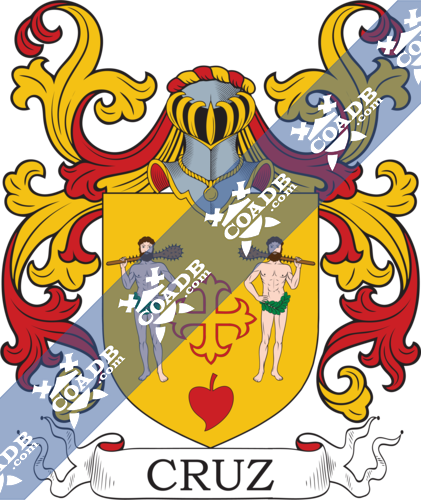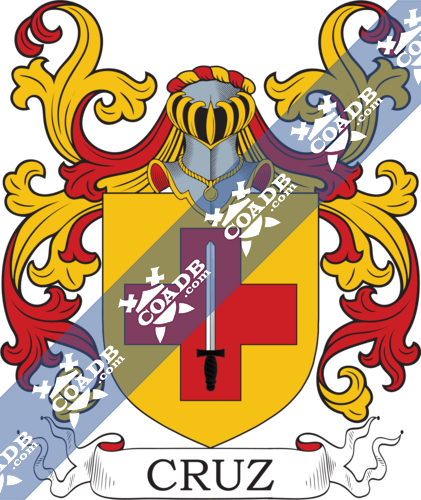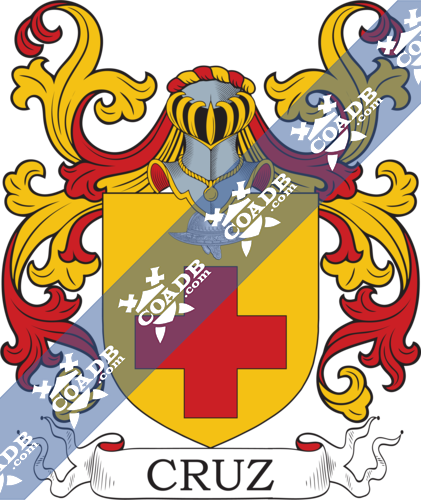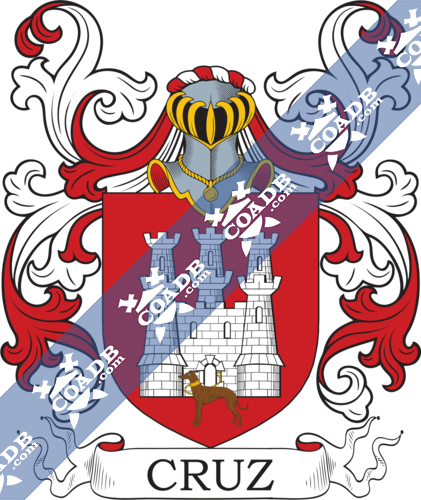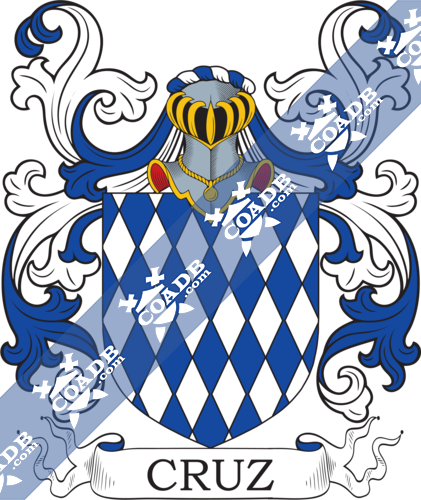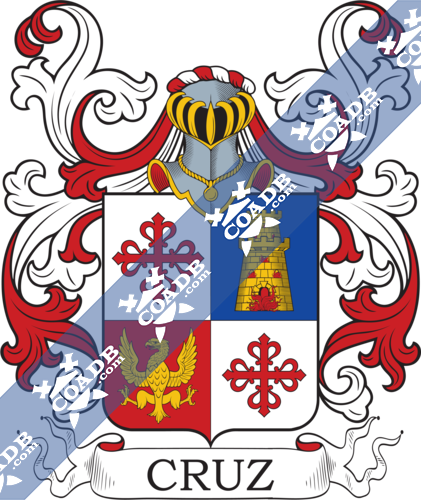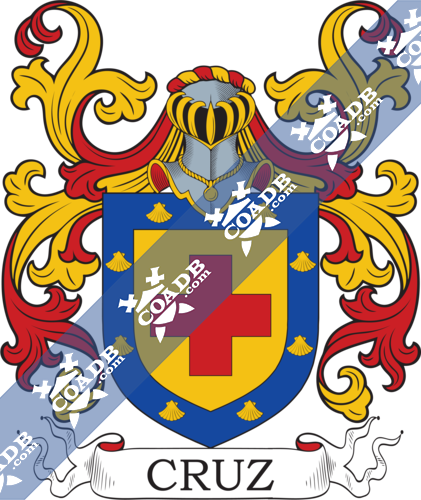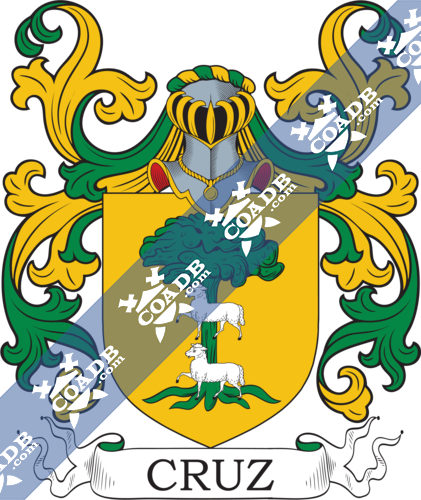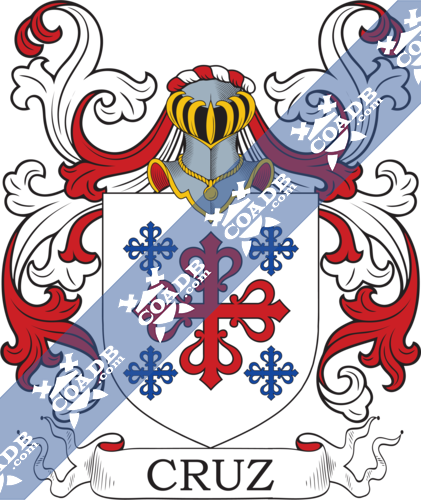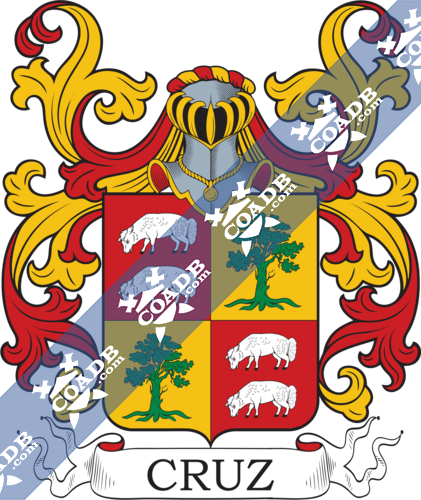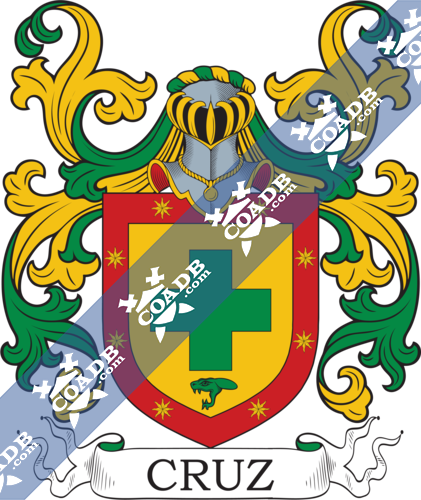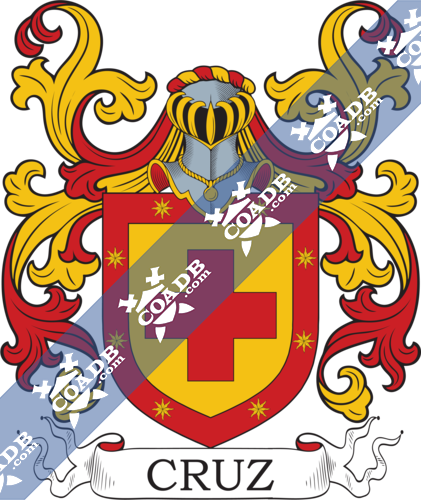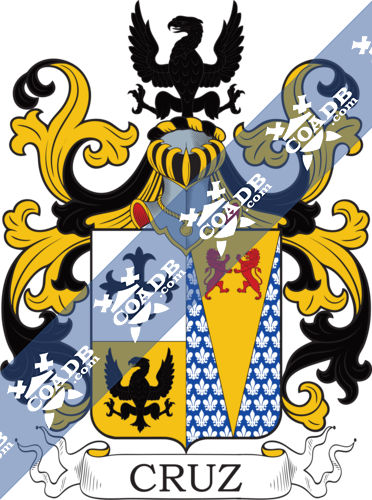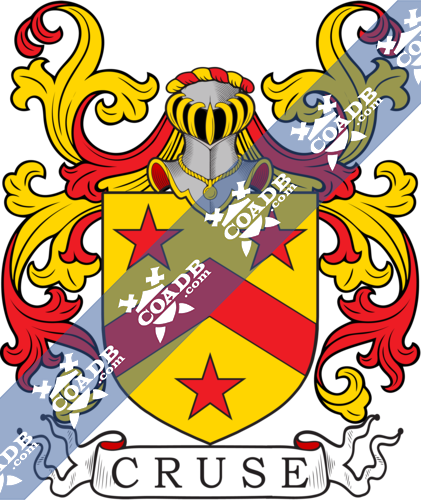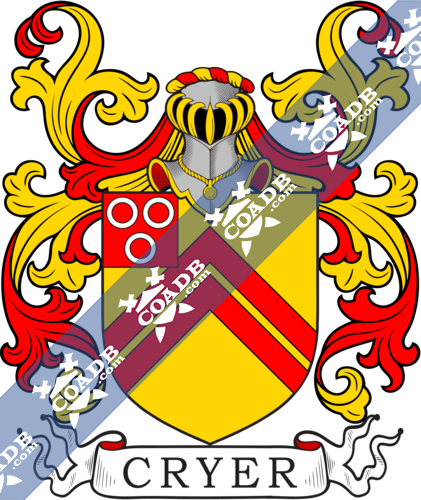Cruz Family Crest, Coat of Arms and Name History
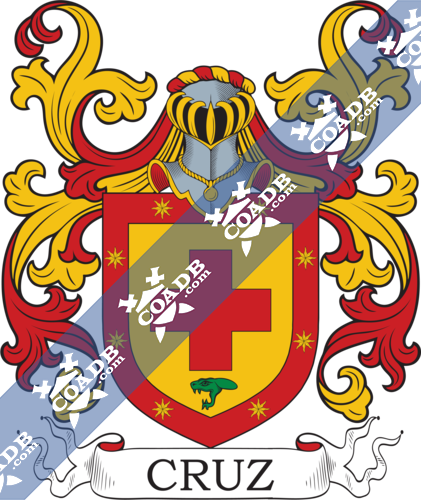
Cruz Coat of Arms Gallery
Don’t know which Coat of Arms is yours?
We can do a genealogical research. Find out the exact history of your family!
Learn MoreSurname Meaning, Origin, and Etymology
Cruz is a surname that is originally from Spain, more specific from the region of Castile at north, however, it can be traced back to the Roman Empire because it has a pre-Christian origin. It is a term derived from the old Latin word “crucis” which can be translated as “cross”. There are two possible reasons for a person to carry this surname, the first one comes from a cross that was set up in a certain point of an old road just to indicate a place of gathering, which could be for eating or maybe a market, and there wasn’t any religious meaning in this. The people that used to live in that location, used to be named after the road signal.
The other possibility is that it began as a way to refer to the person who carried a cross during the festivities of the Christian Church. This person was a religious one but not necessarily part of the clergy or the church. Almost every country in Europe has a spelling variation of this surname in their own language. Thanks to the fact that is associated with a place or with a person who played a role, this surname could be used for different people without a familiar relationship between them, so not all the people who carry it today are part of the same family.
The first record of this surname belongs to Humfrey de Cruce in 1273, who appeared in the Hundred Rolls of Oxfordshire, England, during the reign of King Edward I, who ruled from 1272 until 1307.
Spelling Variations
As it happened with many surnames, Cruz count on some spelling variations, thanks to many reasons that were common in medieval days. It is important to remember that during that time many languages didn’t have grammatical rules, so the words didn’t have a right way of been written. There was also the mix of languages around that time in Europe thanks to many invasions and wars of the Medieval Age. Finally, many scribes wrote the words according to the way they hear them. Because of all those motives, it was normal to find that a single person has different ways to write their names, so the spelling variations were created. In the case of Cruz the most common were: de la Cruz, de Cruz, Cruces, Cruzado, da Cruz, Cruise, Cross, D’Cruz and many others.
Popularity & Geographic Distribution
Nowadays, Cruz is a surname that counts on a high popularity, especially in nations that have Spanish as their official language. Many people use it, in fact, it is used by approximately 2,540,002 people in the entire world, and it is the 186th most common surname. It is most prevalent in Mexico and it has its highest density in Guam. The second country with the highest amount of people with the surname Cruz is Brazil, followed by the United States in third place and Colombia at fourth. All of this information is taken from the census of 2014.
Early Bearers of the Surname
Thanks to the popularity of the surname, there are records of some old bearers of Cruz or a spelling variation in more than just one country. Some of them were Richard del Crosse, who appeared in the Assize Court Rolls of Lancashire, England in 1285, William Cross, in the Subsidy Rolls of Suffolk in 1327 in England. In Spain, the records show to Francisco Lopez Cruz who can be found in the records of “Nuestra Señora de la Antigua” in Valladolid on March 2, 1566, Tomas de la Cruz who was born at Santa Bárbara Mission in California on December 3, 1799. Other Cruz from Spain were Sor Juana Inés de la Cruz, a sixteenth-century poet from Spain and the philanthropist from the seventeenth century Sebastián de la Cruz.
History, Genealogy, and Ancestry
Cruz is a surname that has many lines and branches, some of them with great high detail records. Such is the case of Pablo de la Cruz y Contreras, the Governor of Real Valdivia, Chile from 1762 until 1763.
Pablo Doroteo de la Cruz y Contreras was born in 1714 and was a son of Diego de la Cruz y Rodríguez and María Contreras. Pablo got married to Antonia de Goyeneche y Lope de Lara in 1766, she was a daughter of Esteban Bahamonde de Goyeneche from Spain and María de Lope from Valdivia. They had ten children, the first child was Sor Manuela de la Cruz y Goyeneche who grew up to become a nun, the second child was José de la Cruz y Goyeneche who was born in 1756 and join the military, he married María Carla Luque y Eslava, daughter of Miguel Francisco de Luque and Clara Mariana de Eslaba y Lope de Lara. Then there was María de la Cruz y Goyeneche who got married to Vicente Carvallo.
The fourth child of Pablo and Antonia was Sor Antonia de la Cruz y Goyeneche who also became a nun, the next child was Maria de las Nieves de la Cruz Goyeneche who was born in Valdivia and got married to Caspar del Río Arcaya. The sixth child was Mariana de la Cruz y Goyeneche who was born in Valdivia in 1749 and got married to Francisco del Río Benítez.
The next child of Pablo de la Cruz and Antonia de Goyeneche was Isabel de la Cruz y Goyeneche who got married to Diego Freire de Andrade y Sotomayor. They had children, however, there was one that used his last name in reverse so his offspring can keep the surname Cruz, he was José Miguel Freire de la Cruz who used the last names as Cruz Freire. José Miguel Cruz Freire was born in Hualqui and got married four times, the first one to Flora Josefa Silva González, the second to Andrea Barragán Manríquez, the third to Petrona Hidalgo and the fourth to Pabla Silva.
After four marriages, José Miguel had twelve children, the first one was Juan Nepomuceno Cruz Barragán who was born in Concepción on April 1, 1827. He had children with María Fierro, Pascuala Salas, Juana Pabla Oportus. The first of his eleven children was José Mercedes Cruz Fierro who married Josefa Sánchez and they adopted a child whom they named Baudilio Cruz Sánchez who got married to Zoila Cruz Oportus. Then there were María Cruz Salas who died single and without offspring, Juan Clodomiro Cruz Oportus, José Mauel del Carmen Cruz Oportus, María Etelvina Cruz Oportus, Abelardo Cruz Oportus, Candelario Cruz Oportus, María Concepción Cruz Oportus, Ercilia Cruz Oportus, Glay Eloisa Cruz Oportus and Pabla Cruz Oportus.
The second child of José Miguel Cruz Freire was Petronila de la Cruz Barragán who was born in Hualqui in 1830 and got married to José Miguel Chávez Ríos on August 9, 1851, he was a son of Valentín Chávez and Juana Ríos. Then there was Juana de Dios Cruz Barragán who didn’t have any children, the next ones were Josefa Cruz Barragán from whom there are not records of marriage or offspring, Sevela Avelina de la Cruz Idalgo who was born in Santa Juana in 1836, Benicio Cruz Idalgo who also was born in Santa Juana but in 1837, Felipe de la Cruz Idalgo, who was born in the same place but on August 23, 1838, Feliz de la Cruz Idalgo who was born on January 19, 1841 also in Santa Juana, María Petrolina de la Cruz Idalgo , Tomás Cruz Silva who was born in 1848, Martina de la Cruz Silva who was born in 1851 and José Antonio Cruz Silva who was born in 1858 and got married to Mercedes Domínguez Figueroa.
The following child of Pablo de la Cruz and Antonia de Goyeneche was Ignacia de la Cruz Goyeneche who got married to Miguel Fonseca. Then there was Pablo de la Cruz Goyeneche who was born in 1758 and got married to Dionisia Canales de la Cerda and they had six children: Nieves Cruz Canales de la Cerda who got married to Francisco Rivas, Nicolás Cruz Canales de la Cerda, Candelaria Canales de la Cerda, Manuela Canales de la Cerda, José Canales de la Cerda and Fernando Canales de la Cerda.
The tenth and last son of Pablo de la Cruz and Antonia de Goyeneche was Luis Bartolomé de la Cruz y Goyeneche who was born in 1768 who played important charges in the government on many occasions. He got married to María Josefa Prieto y Espinosa and with her had six children.
The first one was José María de la Cruz Prieto who was born in Concepción on March 25, 1799, he also joined the military and got married to Josefa Zañartu Trujillo and their children were Delfina Cruz Zañartu, who was born in Concepción on February 24, 1837, and got married to Aníbal Pinto Garmedia, José Salomé Cruz Zañartu who had one son Jorge Cruz Evans and Jose María Segundo Cruz Zañartu who didn’t have children.
The next child of Luis Bartolomé de la Cruz y Goyeneche was Luis de la Cruz Prieto who got married to Dolores Pradel y Fernández with whom had two children Luis Cruz Pradel and Sofía Carmen Cruz Pradel who got married to Ricardo Claro Cruz. Then there were Manuela de la Cruz Prieto who got married to Angel José María Prieto Vial, María del Carmen Cruz Prieto who got married to Vicente Claro Montenegro, Jose Antonio de la Cruz Prieto who didn’t got married or have children, and Vicente de la Cruz Prieto who got married to Beatriz Stuardo and had two children: Isabel María Cruz Stuardo and María Mercedes Cruz Suardo.
Early American and New World Settlers
After the Europeans started to travel to America, many of them did the journey with the goal of beginning a new life. They did it across many years and this was how many surnames arrived in America and one of those surnames was Cruz. During the 16th century some of the Cruz that arrived in America were Miguel de la Cruz, who landed in America in 1513, Hernando de la Cruz who arrived at Río de la Plata, Argentina in 1535, Gabriel de la Cruz who arrived to Hispaniola in 1536, Pedro de la Cruz who arrived in Puerto Rico in 1537 and Francisco de la Cruz who got to New Spain in 1538.
The arrival of Cruz to America continued during the 19th century with Miguel de la Cruz, who arrived in America during 1813, Manuel de la Cruz who landed in Puerto Rico in 1816, Rafael de la Cruz who arrived in Texas in 1835, that same year María de la Cruz also arrived at Texas and A. Cruz arrived at New Orleans in 1838. In the next century more Cruz arrived, in 1910 Gregorio Cruz, Manuel Cruz, Santiago Cruz, and Porfirio Cruz arrived at Texas.
Mottoes
We were unable to locate any documented mottoes for the Cruz family.
Grantees
We were unable to locate any documented grantees for the Cruz family.
Notables
Across history there have been users of the surname Cruz that have made important contributions in different fields, some of them are Penélope Cruz (b. 1974) a Spanish actress, the USA politician Rafael Edward “Ted” Cruz, Bobby Cruz (b. 1937) a Puerto Rican salsa singer and religious minister, Celia Cruz (1924-2003) the salsa singer from Cuba, Jason Cruz (b. 1974) an American musician artist and poet, Jose Cruz Jr. (b. 1974) a Puerto Rican baseball player, Ernesto Gómez Cruz (b. 1933) a Mexican actor, Carlos Cruz-Diez (b. 1923) a Venezuelan artist, Wendy Cruz (b.1976) a Dominican Republic cyclist, Roque Santa Cruz (b. 1981) a football player from Paraguay, Leonardo Cruz (b. 1953) a Dominican World Junior Featherweight Champion and many other.
Blazons & Genealogy Notes
1) de la Cruz – Castille – D’or à la croix alésée de gueules acc en pointe d’une tête de serpent de sinople posée en fasce à la bordure du second ch de huit étoiles (8) du champ. English: Or with a cross couped gules accompanied by in base a head of a snake vert placed fesswise a bordure of the second charged with eight etoiles of 8 points of the field.
2) Santa-Cruz – Murcie – Écartelé aux 1 et 4 d’argent à la croix de Calatrava de gueules au 2 d’azur à une tour sommée d’une tourelle d’or vomissant des flammes de gueules par les fenêtres et la porte au 3 de gueules à l’aigle d’or. English: Quarterly 1st and 4th argent with the cross of calatrava gules 2nd azure with a tower surmounted by a turret or emitting flames gules from the windows and the door 3rd gules with an eagle or.
3) Santa-Cruz – Espagne, Anvers – Parti au 1 coupé a d’argent à la croix fleuronnée de sable b d’or à l’aigle de sable au 2 d’or à deux lions affrontés de gueules l’or chaussé arrondi d’azur à une fleur-de-lis d’argent Cimier une aigle issante de sable. English: Per pale 1st per fess a) argent with a cross flory sable b) or with an eagle sable 2nd or two lions affrontant [face to face] gules the or chausse [division from middle base to top dex & sin] bowed azure with a fleur de lys argent Crest: an eagle issuant from sable.
4) A la casa solar gallega próxima a Pontevedra se le señalan éstas: En campo de oro, una cruz llana de gules. Bordura de azur, con ocho veneras de plata.Así las usó la rama establecida en Jalapa, en la Florida y Chillán (Chile).Dichas armas traen los de Castilla, radicados en Galicia, pasados a Cuba y a Talca (Chile), según Vicente de Cadenas.
5) En la calle del Puente, en la Plaza de Méndez Núñez y en la Plaza de Teucro, de Pontevedra, constaban las siguientes armas para los Cru: Un pino (o árbol) arrancado, y resaltados dos corderos sobre el tronco. (tinctures assumed by artist).
6) En el Palacio de la Plaza de Méndez Núñez, de Pontevedra, constan: Una cruz grande, a manera de la de Calatrava, y en el hueco de los cuatro brazos otras cuatro más pequeñas, y dos hojas de higuera.(tinctures assumed by artist).
7) En la fachada de la Iglesia de Santa Clara, de Pontevedra, constan las siguientes armas de los Cru: Escudo cuartelado: 1º y 4º, dos corderos paciendo, puestos en palo, y 2º y 3º, un árbol arrancado.(tinctures assumed by artist).
8) Otros de la misma casa de Briviesca: En campo de oro, una cruz llana de sinople, y en la punta una cabeza de serpiente de sinople. Bordura de gules, con ocho estrellas de oro de ocho rayos.
9) Los originarios de Castilla y radicados en Moguer (Huelva) y Madrid, según Vicente de Cadenas, traen: En campo de oro, una cruz llana, de gules. Bordura de gules con ocho estrellas, de oro, de ocho puntas cada una.
10) Algunos de Vizcaya traen: En oro, una cruz hueca y floreteada de gules y a cada lado de ella un salvaje con una maza en la mano. En la punta del escudo una panela de gules.
11) Los radicados en Santa Eufemia (Orense) y Madrid, según Vicente de Cadenas, traen: En campo de oro, una cruz, de gules, cargada de una espada, de plata, encabada de sable.
12) Los de Pamplona usan: “Una cruz y en la parte superior un morrión”.
13) Otros Cruz: En campo de gules, un castillo de plata, y a su puerta un lebrel pardo atado a ella con cadena de oro.
14) Los apellidados de la Cruz-Ordaz, pasados a Cuba, según Vicente de Cadenas, usan: Escudo fusado de plata y azur.

